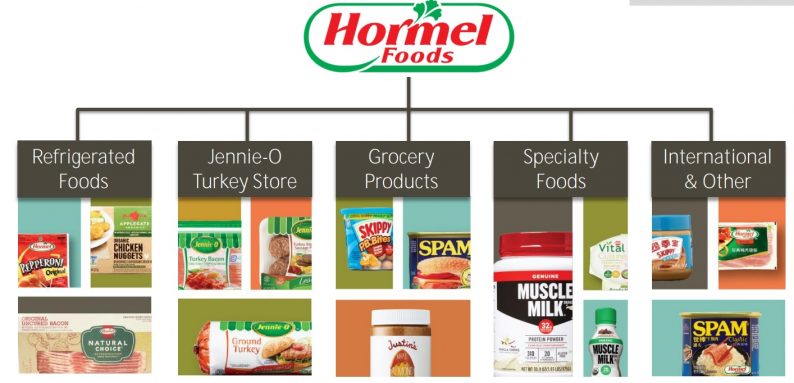Hormel Foods (HRL) is one of the truly elite stocks when it comes to consistent dividend growth and shareholder value creation.
Thanks to 51 straight years of dividend increases Hormel is now a dividend king, a group of stocks that have historically been some of the most successful at growing investor income and wealth.
Best of all, this highly recession resistant, low risk stock, which has grown its payout by 10.8% annually over the last 20 years, has underperformed the market by nearly 20% over the past year.
Let’s take a closer look to see why Wall Street has become so negative about Hormel and if now could be a reasonable time for long-term investors to give the stock closer consideration as part of a diversified dividend growth portfolio.
Business Overview
Founded in 1891 in Austin, Minnesota, Hormel Foods has proven to be one of the most resilient food providers in the world. The company’s well known brands include Skippy peanut butter, SPAM meat, Dinty Moore stew, Muscle Milk protein drinks, Wholly Guacamole dips, Jennie-O turkey, and numerous Hormel-branded products.
The business operates under five segments:

Source: Hormel Investor Presentation
Segments
Refrigerated Foods (49% of sales, 43% of profit in 2016): sells branded and unbranded pork and beef products for retail, foodservice, and fresh product customers.
Jennie-O Turkey Store (18% of sales, 24% of profit): sells branded and unbranded turkey products for retail, foodservice, and fresh product customers.
Grocery Products (18% of sales, 19% of profit): sells shelf-stable food products predominantly in the retail market (Wal-Mart accounted for 14% of company-wide sales last year).
Specialty Foods (10% of sales, 8% of profit): sells private label shelf stable products, nutritional products, sugar, and condiments to industrial, retail, and foodservice customers.
International and Other (5% of sales, 6% of profit): sales of HRL’s products in international markets such as China.
Business Analysis
Hormel Foods is a rare breed in consumer foods because it has managed to build a moat in a highly competitive industry. That’s courtesy of its strong focus on adding only top name brands to its portfolio over time and investing heavily in advertising.
For example, Hormel owns the #1 or #2 brands in 35 product categories thanks to a number of well-timed acquisitions and focused brand investments:
However, Hormel’s ability to not just meet but exceed its ambitious long-term growth goals of 5% top line and 10% bottom line growth isn’t just a function of steady industry consolidation. The company has wisely chosen to invest in building its brands over time, in order to achieve strong organic growth.

Hormel is a big spender on R&D, what it calls “innovation investments,” to help launch new product offerings both at home and abroad. However, as one of the largest consumer-branded food and meat manufacturers, Hormel’s primary key to success is favorably altering customers’ perceptions of its products to gain loyalty and market share.
The company spent approximately $204 million on advertising last fiscal year, an amount nearly six times greater than Hormel’s spending on R&D.
With many of its brands dating back over 50 years (e.g. SPAM and Dinty Moore were introduced in the 1930s) and supported by billions of advertising dollars over the years, consumers know and trust many of Hormel’s products.
Investment Into Existing Brands

Source: Hormel Investor Presentation
The company also benefits from economies of scale. As one of the larger players in the market, Hormel is able to achieve lower production costs than smaller rivals and squeeze more value out of each advertising dollar it spends by extending well-known brands into adjacent product categories. Extensive regulations by the U.S. Department of Agriculture also disadvantage smaller competitors.













Leave A Comment